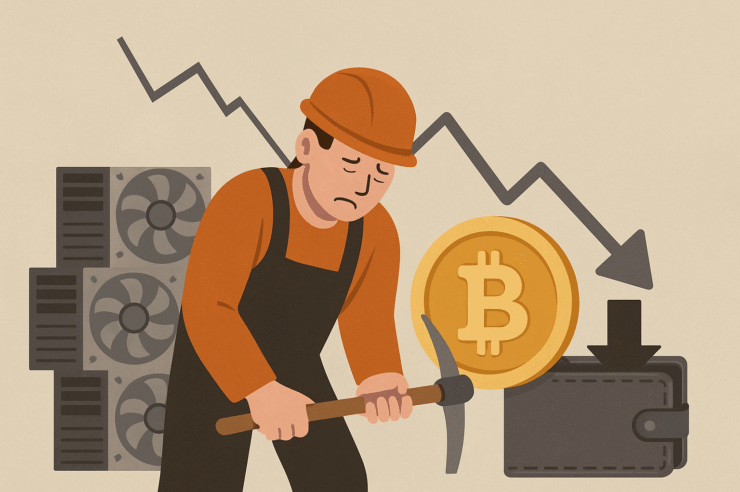Introduction
As Bitcoin continues its volatile journey through the financial landscape, an overlooked but critical part of the ecosystem—mining—faces an existential threat. Recent reports, such as one published by Bitcoinist, reveal that Bitcoin miners are now severely underpaid compared to historical norms. While mainstream attention often focuses on price fluctuations or ETF approvals, the silent pressure building under the Bitcoin network infrastructure could result in long-term implications if not addressed.
The situation, now being referred to as a “ticking time bomb,” is the result of a complex mixture of decreasing block rewards, halving events, rising network difficulty, and market inefficiencies. Understanding this evolving crisis requires diving deep into the economics of mining, the technological challenges, and the potential consequences for the entire crypto industry.
Understanding Bitcoin Mining: Economics And Incentives
Bitcoin mining serves two primary functions: validating transactions and securing the blockchain. Miners contribute computational power—measured in hash rate—to solve complex mathematical puzzles. For their efforts, they are rewarded in Bitcoin (BTC), earning block rewards and transaction fees.
However, this reward mechanism is not fixed. Every 210,000 blocks (roughly every four years), a halving event reduces the reward per block by 50%. The most recent halving occurred in April 2024, slashing rewards from 6.25 BTC to 3.125 BTC. This significant reduction has made it harder for miners to sustain operations, especially in a competitive environment with high energy and equipment costs.
Why Are Bitcoin Miners Underpaid In 2025?
According to recent data from industry analytics platforms such as CryptoQuant and Glassnode, miners are now operating under tight margins, if not outright losses. The reasons include:
1. Post-Halving Revenue Shock
The 2024 halving sharply reduced the block reward to 3.125 BTC. While previous halvings have eventually led to price increases that offset the decline in rewards, the post-2024 price rally has been weaker than expected. The Bitcoin price, fluctuating around $65,000 in June 2025, has failed to create a strong enough earnings buffer for most mining operations.
2. Rising Mining Difficulty
Bitcoin’s difficulty adjustment algorithm ensures that blocks are mined roughly every 10 minutes. As more miners join the network and computing power increases, the difficulty level automatically adjusts upward. In 2025, the mining difficulty has hit all-time highs, meaning more energy and computing power are required for the same reward.
3. Higher Energy Costs
Global energy prices have not stabilized since the 2022–2023 inflation wave. Many mining farms located in regions like Texas, Kazakhstan, and parts of Europe are now paying higher electricity rates, significantly impacting profit margins.
4. Decreased Transaction Fees
In 2021 and 2022, high network congestion led to higher transaction fees that supplemented miners’ revenue. However, with increased efficiency from Layer 2 networks like the Lightning Network and fee market saturation, transaction fees have dropped to historically low levels in mid-2025.
What The Data Tells Us: A Deep-Dive Into Miner Metrics
To truly understand the mining crisis, it’s essential to look at key on-chain metrics and profitability indicators.
Hash Price Collapse
The “hash price” is a key profitability metric that calculates the USD revenue a miner earns per terahash per second (TH/s) of computing power. As of June 2025, the hash price is hovering at its lowest level in three years—indicating that miners are earning less than ever per unit of effort.
Miner Reserve Depletion
Data from CryptoQuant shows a significant decline in miner BTC reserves, as many mining operations are forced to sell their holdings just to stay afloat. This not only places sell-side pressure on the market but also indicates a lack of long-term confidence.
Increased Miner Capitulation
The Miner Capitulation Index, which gauges when miners are selling aggressively due to unprofitability, is flashing red. Smaller miners and independent operations have begun shutting down their rigs, unable to compete with large, capital-heavy mining conglomerates.
Global Mining Landscape: Winners And Losers
The economic disparity is becoming more pronounced across different regions and mining setups.
United States: Regulation vs. Infrastructure
The U.S. hosts a significant portion of the global hash rate. However, increasing regulatory uncertainty from the SEC and energy regulations in states like New York have made expansion difficult. Conversely, Texas and Wyoming continue to offer mining-friendly policies.
Kazakhstan and Russia: High Hash Rate, Low Margins
Although energy prices are relatively lower in these regions, political instability and restrictive legal frameworks have forced many miners to relocate. Equipment seizures and policy U-turns have disrupted mining hubs in Central Asia.
Latin America and Africa: Emerging Players
Some countries in Latin America (e.g., Paraguay, El Salvador) and Africa (e.g., Nigeria, Kenya) are attempting to attract miners with renewable energy incentives. However, infrastructure limitations and intermittent connectivity still pose operational challenges.
Impact On The Bitcoin Ecosystem
The mining crisis has broader implications for the health of the Bitcoin network and the integrity of decentralization.
1. Centralization Risk
As smaller miners exit the market, mining power becomes increasingly concentrated in the hands of a few large players. This centralization not only undermines the security model of Bitcoin but also creates political and economic vulnerabilities.
2. Network Security
A decrease in active mining participants could reduce the overall hash rate, making the network more susceptible to attacks. Although this hasn’t happened yet, it remains a long-term concern.
3. Market Liquidity and Volatility
As miners sell off their reserves, this introduces additional supply into the market, contributing to price volatility. The consistent sell pressure from underpaid miners also dampens bullish momentum.
Are There Any Solutions On The Horizon?
Several proposed solutions aim to restore miner profitability and maintain network security.
Adoption of Layer 2 Incentives
While Layer 2 solutions are often designed to reduce congestion and fees, some proposals aim to share revenues from Layer 2 protocols with base-layer miners. This could help supplement lost income.
Transaction Fee Reform
There is growing debate within the developer community around implementing fee market reforms or even introducing optional tips to incentivize miners. While controversial, such proposals highlight the need for innovation.
Mining Efficiency Technologies
New hardware innovations, such as the latest models from Bitmain and MicroBT, offer improved efficiency. Miners who can afford to upgrade may regain profitability, although the capital expenditure required is steep.
Renewable Energy Integration
Utilizing cheaper and more sustainable energy sources like hydro and solar power can drastically cut operating costs. Mining companies that succeed in this transition may survive the revenue crunch.
The Historical Context: Is This Really New?
It’s worth noting that mining crises are not new. Similar profitability shocks occurred in:
2014–2015: Following the Mt. Gox collapse, BTC prices dropped below profitability levels for many miners.
2018–2019: The “crypto winter” forced many miners to liquidate assets and exit the market.
2020–2021: The China mining ban caused a sudden collapse in hash rate, but miners relocated and recovered over time.
However, the current situation in 2025 differs because of its systemic, global scope—touching every major region, impacting every miner tier, and occurring during a supposed bull phase, not a market collapse.
Is A Bitcoin Price Surge The Only Hope?
A widespread belief persists that only a sharp price rally—potentially to $100,000+—can resolve this crisis by restoring profitability despite halved rewards. This would require significant institutional capital inflows, favorable macroeconomic conditions, and reduced sell pressure.
However, relying solely on price appreciation is not sustainable. It ignores the structural problems in Bitcoin’s incentive mechanism as halvings continue indefinitely.
Conclusion
Bitcoin mining has always been a high-risk, high-reward venture. But the current revenue crisis facing miners in 2025 is deeper and more complex than past cycles. It exposes the delicate balance that underpins the world’s largest decentralized financial network.
With miner profitability at historic lows, the very security and decentralization of Bitcoin could be at risk if solutions are not implemented. Whether through innovation, collaboration, or strategic reform, the ecosystem must adapt to protect its backbone—the miners.



